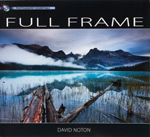Photo Insight – David Noton
David Noton explains how he used infrared imagery to create this radical interpretation of this picturesque Italian landscape

One of the foremost travel and landscape photographers working today, David Noton tirelessly travels the world in search of new challenges, which he shares with you here
Infrared photography offers a completely different way of looking at the world around us. It?s fun to do, but also quite challenging because you?re literally creating photographs with light that you can?t see. The key to working successfully with infrared lies in understanding what?s happening technically and knowing how different subjects appear when you?re recording only infrared light.
Last year, I shot this scene just outside the village of Campi Vecchio in the Monti Sibillini National Park in Umbria, Italy. It?s a picturesque and beautifully located hilltop village. I?d photographed it before, but I?d never been really satisfied with what I?d got from the location.
On this visit, I found that a barley crop had been planted in one of the fields. I had arrived with the intention of shooting colour, which I did, but I also thought the scene would work well in infrared.
So, on the following day, I returned to the same place with my old Canon EOS-1Ds Mark II, which I have had converted for infrared photography. The conversion process is irreversible, but if you have a camera around that?s past its sell-by date it is worth considering.
I usually shoot landscapes at dawn and dusk, but as infrared light is quite low in contrast I opted to use the bright, hard, high-contrast light of the middle of the day. When I arrived, the weather was bright and clear and there wasn?t a cloud in the sky. This was a little disappointing, as I knew the blue sky would go completely black and I wanted to use some clouds to add both detail and drama.

However, I noticed there were some bright-green leaves on the overhanging trees at the edge of the field. I knew these would turn a lighter shade of grey in infrared, so I decided to include them at the top of the frame.
As with any other photography, composition is crucial. I aimed to keep it simple while ensuring there was good foreground interest and a balanced composition. I didn?t want anything in the frame that didn?t deserve to be there.
I set up the camera on a tripod and attached one of my favourite lenses for landscape work, the Canon TS-E 24mm f/3.5L tilt-and-shift lens. It was useful here because I was looking up a steep hill towards the village. If I?d just pointed the camera up at the village with a conventional wideangle lens, the trees on the right would have leaned distractingly into the frame.
Also, although the village is quite distant, the verticals of the buildings in the village would have been falling backwards. Using the ?shift? function to correct the converging verticals worked well.
It was a breezy day and I wanted to record movement in the barley and the foliage, so I used a 10-stop ND filter to hold back the exposure time. Once you?ve attached that filter to the lens you can?t see anything through it, so you have to frame up your shot and do your test composition and exposure before you attach the filter. Then calculate your exposure compensation for 10 stops, attach the filter and make the exposure.
That?s the theory in terms of using visible light, but I didn?t know exactly what effect the filter would have with infrared.
I estimated that it would effectively be reduced to a 5-stop ND grad filter, but I had to do a few test shots before I zeroed in on the correct exposure. For this image, I exposed for 16 seconds at f/18, at ISO 50.
Infrared images also need special handling at the post-capture stage. Initially, you have quite a ?soft? image that comprises different shades of red. So first you have to convert it to monochrome at the raw conversion stage, which I do by simply desaturating. At the same stage I also add some contrast by adjusting the curves, before fine-tuning the image in Photoshop.
In this case, I think the resulting image works well and offers a completely different take on the conventional landscape. I like the effect of the movement, which adds another interesting element to the slightly strange, dream-like atmosphere that infrared photography creates.
 David Noton?s new book Full Frame is now available. It follows David?s journey to ten different locations around the world and gives invaluable insight into his approach and working methods. For more details, visit www.davidnoton.com
David Noton?s new book Full Frame is now available. It follows David?s journey to ten different locations around the world and gives invaluable insight into his approach and working methods. For more details, visit www.davidnoton.com
David Noton was talking to David Clark






